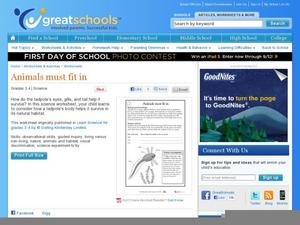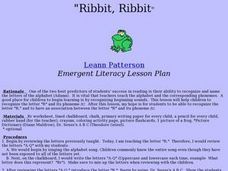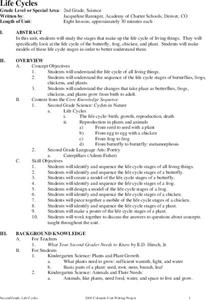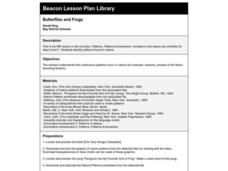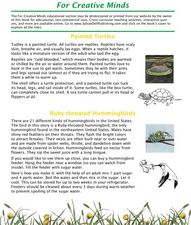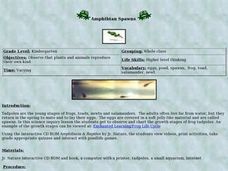Curated OER
Frogs, Fabulous Frogs
Students have the opportunity to both interpret and replicate the different shapes and textures observed in the life cycle of a frog. When students apply the watercolor wash to the crayon texture rubbings the designs take on a...
Curated OER
Animals Must Fit In
A instructional activity on tadpoles is here for your young biologists. Learners read a short paragraph on tadpoles, then answer three questions regarding how parts of their bodies help the tadpole to survive in the pond. There is a good...
Curated OER
The Spring Peepers are Back
In this frogs and toads activity, students examine detailed color pictures of 7 varieties of amphibians. Students write the name of each frog or toad on the line. There is no word bank.
Curated OER
Animals
Second graders define and describe the characteristics of a mammal and a mammal's importance to man. They also describe the life cycle of a frog and compare and contrast a larva and an adult frog. Finally, 2nd graders study and explain...
Curated OER
Life Cycles
Learners are introduced to the concept of life cycles and identify the growth order and different stages attained by various animals. They view slideshows and video of butterflies and frogs as they change through the various stages of...
Curated OER
How Do Animals Change as They Grow?
This PowerPoint includes text, diagrams, and clip art describing characteristics of a tadpole as it changes into a frog, as well as a description of the related life cycle stages. Although the title indicates the broader theme of...
Lakeshore Learning
Story Sequencing Activity
Pollywogs, tadpoles, and frogs. Here's a sequencing exercise that combines story telling and science. Kids paste illustrations of the life cycles of frogs in order on a story sheet.
K5 Learning
The Life Cycle
Studying plant, animal, or insect life cycles? Pair a science unit with a reading comprehension worksheet on life cycles. The passage touches briefly on butterfly, plant, frog, and dog life cycles before prompting readers to answer six...
Curated OER
Tables
Can you read this table? Learners begin to comprehend data analysis through examining two simple tables and answering comprehension questions. The first gives characteristics about three animals in yes-or-no format (i.e. "eats insects,"...
Curated OER
Ribbit! Ribbit!
Students research a frog's life cycle and habitat using books, the Internet and lecture. Students make origami frogs, write letters to Toad from Arnold Lobel's "Frog and Toad" and participate in a simulated camouflage activity.
Curated OER
Oviperous Animals
Students explore animals that come from eggs using pictures and information taken from the Internet. The reading of the stories, "Chickens Aren't the Only Ones" and"Tap Tap, the Egg Cracked" is used as a introduction to the topic.
Curated OER
Migration Woes
Students are able to describe the reproductive cycle of the gopher frog. They are able to describe the impacts of habitat loss and degradtion on gopher frog populations. Students are explained that many factors limit the survival of...
Curated OER
Life Cycle
In this science worksheet, 3rd graders will investigate the life cycle of butterflies, frogs and chickens who hatch from eggs by creating a wheel. Students cut and assemble this wheel with windows that can display the pictures of changes...
Curated OER
Spelling: The Emperor's Egg
In this spelling worksheet, students darken the circle next to the correctly spelled word. Words are spelling 3 times, twice incorrectly.
Curated OER
Zebrafish Development
Students examine the early development of zebrafish as a model for embryo development in humans. They observe various stages of zebrafish reproduction from sperm and eggs to fertilized eggs and hatchlings.
Curated OER
Animals Are Different
Each animal is different! Showcase animal characteristics through a series of questions based on simple images of well-known animals. This worksheet has learners examining 8 animals: rabbit, penguin, parrot, dolphin, bear, ostrich, duck,...
Curated OER
Sunken Millions
This PowerPoint features a game based on the animal life. The interactive slides include 20 questions about animal needs, animal groups, and animal traits. The questions include multiple choice answers and 4 different levels of...
Curated OER
Life Cycles
Students explore the life cycle of living things through the eight lessons of this unit. The butterfly, frog, chicken, and plant are inspected and form the basis of the work done in this unit.
Curated OER
Life Cycles: A Never-Ending Story
Second graders describe the sequence of events in the life cycles of a butterfly, frog, and a deer. They observe the differences and similarities of parents and babies. They also discover that at different stages the animals can be...
Curated OER
Life Cycles
Third graders investigate the stages of animal life cycles. They examine an egg and compare it to an inanimate object, read a booklet about the life cycle and define key vocabulary terms, and observe a mealworm. Students then design a...
Curated OER
For Creative Minds: Tudley Didn't Know
Students discover facts about the animals in John Himmselman's book, Tudley Didn't Know, and make a paper turtle. In this marsh animals lesson, students first read the book Tudley Didn't Know. Students read facts about painted turtles,...
Curated OER
A Tree Is A Home...
In this science instructional activity, 3rd graders answer 12 clues to find the answers to a crossword puzzle that is focused on things that live in trees. They use words such as butterfly, tree frogs, raccoons, and squirrel.
Curated OER
Amphibian Spawns
Students observe tadpoles as they gradually change into adults. In this amphibian biology lesson, students watch tadpoles in a tank in the classroom, keep a daily record of what they observe, and chart the growth development of the...



